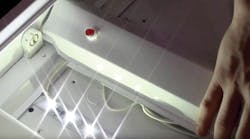If part of your job is overseeing building maintenance and management from an electrical standpoint, how much thought do you give to emergency lighting? Providing sufficient illumination to light the way in the event of an emergency is one of those things you may take for granted. Emergency lighting is generally thought of as “set it and forget it.” That’s a mistake — no matter what type of building you’re responsible for.
Staying compliant with the latest building safety codes is essential, and lighting rules and regulations change over time. You need to periodically assess your emergency lighting systems to ensure they comply with the most recent lighting regulations. California’s Title 20, for example, is one of the latest codes covering energy regulations. It has a direct impact on emergency lighting, including new rules about battery charging specifications, power ratings, and centralized lighting controls.
Keeping current with emergency lighting rules and regulations is mostly a matter of understanding the lighting requirements and testing emergency lighting systems. New lighting systems are continually hitting the market with new features to address new regulations, such as new testing and monitoring features and new capabilities to integrate emergency lighting into building automation and centralized lighting controls. Understanding some of the basic requirements of emergency lighting will help you stay compliant without a big outlay for replacements and retrofits.
Types of emergency lighting
Lighting systems continue to evolve with new technology, but the basic purpose of emergency lighting remains unchanged — to provide sufficient light to help building occupants exit safely in the event of an emergency. That means safety regulations require a minimum amount of light and a minimum amount of operating time to ensure a safe exit. Emergency lighting is basically defined as any approved illumination source that activates when the power goes out.
There are various types of emergency lights designed for different environments and applications. Thermoplastic lights, for example, are lower in cost and typically are used for indoor installations. Steel fixtures tend to be better suited to warehouses, parking structure, or large open environments. Other emergency lights need to be waterproof for installation outdoors or in damp locations. Some emergency lighting is installed in plain view while others are recessed or hidden in existing light fixtures. There also are architectural lights designed to blend into the building décor.
Emergency lighting is also moving away from halogens, fluorescents, and other types of lamps and standardizing on LEDs. LED lighting is ideal for emergency lighting because it is highly reliable, heat-resistant, and less susceptible to breakage. In addition, LEDs are low energy, which means they can be powered by batteries for a considerable time. The industry is seeing more LED light strips installed in existing light fixtures with their own drivers and power packs so no additional emergency-only luminaires are needed.
Using LEDs for emergency lighting also makes it easier to stay compliant with various building regulations, because they can be programmed for any light output that is required — and they can be installed virtually anywhere.
Know your emergency lighting safety codes
Building codes for emergency lighting vary from place to place. In New York City, for example, emergency lights must be encased in steel housings and all possible exits illuminated — not just those that are part of an exit plan. New York City also requires a minimum of 2 fc illumination at floor level, which is higher than the 1 fc illumination the national building code requires. Chicago has different emergency lighting restrictions. For example, in this city, emergency lighting also must be activated during a brownout (i.e., when the power drops below 10%). There are different requirements for public buildings, residences, businesses, and other types of structures, just as the rules differ for two-story structures versus skyscrapers because of the differing times required to exit the building.
The National Fire Protection Association (NFPA) and the International Building Code (IBC) provide common benchmarks for emergency lighting requirements.
The NFPA 101: Life Safety Code stipulates that emergency illumination is required for all buildings addressed in the code, but is only required for exit access. This means lighting stairs, aisles, ramps, corridors, escalators — any path that can be used for an exit in the event of an emergency. NFPA 101 and IBC 2012 require an average of 1 fc along the path of egress. The NFPA code also dictates that emergency lighting has to illuminate within 10 seconds of a power outage, and that battery-powered lights provide illumination for a minimum of 1.5 hours. After 90 minutes, the minimum illumination requirement drops from 1 fc to an average of 0.6 fc (0.65 lux) minimum.
California Energy Commission (CEC) Title 20, which applies to buildings in California and Oregon, is the latest code to affect emergency lighting, including battery charger systems and self-contained lighting controls. NFPA 101 requires that battery-supported lighting, such as emergency lighting, be tested regularly, including testing for power readiness and for battery discharge time. In the case of emergency lights, this means being able to power the light at the minimum illumination required for at least 90 minutes.
External emergency lighting building codes also vary, so be sure you know the code that applies to your building and grounds to ensure compliance. Defining a path of egress will differ as well. NFPA, for example, defines “public way” as an egress 10 feet wide and 10 feet high. The IBC stipulates “emergency lighting shall be provided at the door,” and outdoor emergency lighting needs to light the path from the door to the public right of way. Depending on the location of your exits and the layout of the surrounding grounds, emergency lighting requirements will differ, depending on the regulations that need to be followed.
Battery power and light levels
All emergency lighting is required to deliver a minimum of 90 minutes of illumination for safe egress, which equals 90 minutes of battery-powered lighting. That means batteries have to be installed and maintained, so they need to be tested periodically to make sure they can perform as required.
LEDs offer an advantage here as well, since they consume less power and thus require smaller batteries. Some LED emergency manufacturers are also making their emergency LED drivers programmable so they can accommodate from 90 to 360 minutes of emergency lighting, which is ideal if you want to use the same emergency lighting fixtures throughout a larger building.
Additionally, there are choices in the types of batteries/drivers available. Battery chemistry is evolving to provide longer life and greater reliability. Lead-acid batteries are being replaced by nickel-cadmium batteries that are smaller, lighter, and last longer. More manufacturers are introducing lithium iron phosphate batteries for emergency lighting.
Batteries tend to last from five to 10 years, but you still want to look for emergency luminaires that offer replaceable batteries. Otherwise, you’ll have to replace the entire fixture.
Retrofit options
Changes in safety standards also call for more emergency lighting retrofits, which often means it is more cost-effective to swap out fluorescents for LEDs.
You can add an emergency ballast and battery to a T12 or T8 fluorescent light fixture; however, fluorescents consume more power — and part of CEC Title 24 requires lighting be more energy efficient. There are T8 and T12 LED conversion kits that replace fluorescent tubes with LED strips that can be installed in the same luminaires. T12 and T8 LED fixtures meet the lower power requirements of Title 24 and can be readily equipped with an extra emergency LED driver with battery backup. For some installations, adding standalone LED emergency lighting to existing luminaires is more cost effective. The add-on emergency LEDs and drivers can be installed quickly and wired directly into the existing fixture.
LED form factors continue to become smaller and more versatile so LED lighting, including emergency lighting, can be installed almost anywhere. LED drivers are more compact and easy to install, and newer LED emergency lights come with an integrated emergency driver, making them lower profile and easier to install.
Managing emergency lighting
All emergency lighting systems require maintenance and management. In addition to regular testing, you want to ensure your emergency lights are operational and ready between tests. It’s recommended to test all emergency lighting once each month and perform a complete 90-minute battery test at least annually.
UL 924 requires that indicator lights be part of a self-contained emergency lighting system. Emergency lighting manufacturers are starting to incorporate two-color indicator lights and testing systems into emergency lights in compliance with UL 924. Most manufacturers have some kind of indicator to show power; however, more vendors are providing red/green LED indicators to indicate readiness. Some of the more sophisticated LED indicators can provide information about battery status, test status, driver function, operating temperature, and more.
As building management technology matures, emergency lighting is becoming part of building automation. Emergency lighting is now often considered as part of Digital Addressable Lighting Interface (DALI), ZigBee, and Bluetooth mesh control systems, so lights can be monitored and tested from a central interface. For example, using DALI emergency lighting tests can be conducted remotely and the results logged for proof of compliance.
Whether you’re looking at new construction or building retrofits, emergency lighting shouldn’t be an afterthought. Ensure from the outset that your emergency lighting systems comply with the appropriate regulations — and that you can present proof of compliance if needed. Make sure your emergency lights are up to date and conform with national safety regulations and local building codes. Most important, test them regularly to ensure they can continue to do the job. Also look for lighting units that are reliable as well as versatile, and take the time to set up test and monitoring protocols in advance. It’s your best strategy to stay compliant with emergency lighting standards.
Garcia is the Director, LED Emergency and Advance R&D, for Fulham Co. Inc., Hawthorne, Calif. He can be reached at [email protected].





